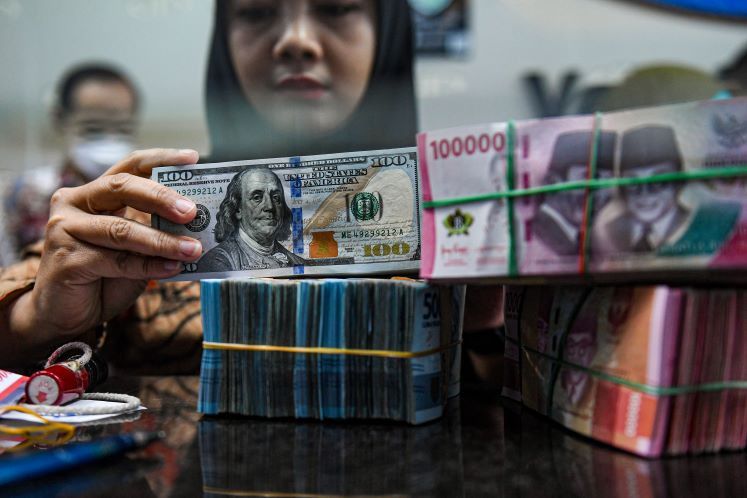THE recent fluctuations of the rupiah against the US dollar can be likened to an intricate opera, reminiscent of Richard Wagner’s renowned works that blend poetry, visual art, music and melancholic drama into a beautiful symphony.
Just as Wagner revolutionised opera with his genius for integrating diverse elements, Indonesia’s economic strategy, specifically in its handling of the currency, requires a similarly harmonious approach.
The rupiah’s decline, influenced by both external and internal pressures, mirrors the complex movements of an orchestral piece.
On the external front, uncertainties surrounding the US Federal Reserve’s (Fed) interest rate policies and robust US data, such as US consumer spending and the manufacturing purchasing managers’ index (PMI), are contributing to a strengthening US dollar, further exerting pressure on the rupiah.
Not to mention, the market still has concerns over Indonesia’s over-expansive fiscal policies in financial year 2025.
Seasonal trends also play a role, including increased demand for US dollars leading up to the Aidilfitri celebrations, foreign profit-taking activities as indicated in broker data, the anticipation of significant US announcements during Indonesian holidays and the approaching period of dividend distributions.
Fortunately, the recent statement by Fed chairman Jerome Powell, combined with easing US PMI service data, has helped alleviate tensions in the rupiah.
We believe Bank Indonesia (BI) still has room to conduct triple interventions in the market without raising the seven-day reverse repo tate in the second quarter.
Our impulse response function (IRF) suggests that intervention through foreign exchange (forex) reserves will provide a prompt response to the rupiah’s appreciation against the US dollar.
The US$142bil of forex reserves is still enough to provide that buffer while at the same time collecting all the export proceeds from some of the big exporters that are still not complying with regulations.
Our estimates suggest that BI can collect approximately US$8bil to US$10bil of reserves from these exporters, which is more than enough to secure solid forex reserves.
Cost of intervention
A US$1bil intervention will be sufficient to temporarily adjust the rupiah to approximately 15,700 against the US dollar.
If this is too expensive, US$500mil will suffice to maintain the rupiah at around 15,800. What about the alternative of raising the rate?
Our IRF also suggests that increasing it by 25 basis points will, surprisingly, result in a 50-basis point depreciation of the rupiah against the US dollar. However, considering what the Bank of Japan has done before, raising the rate but observing the yen’s depreciation, this is not entirely surprising.
Psychological level
Of course, the seven-day rate will eventually cause the rupiah to appreciate in the following months. However, we must be aware that the short-term depreciation will be enough to create an untamed effect of depreciation, further pushing the rupiah to its psychological level of 16,000 against the US dollar.
Additionally, there is a need to be cognisant of the contractionary growth effect it will create in the mid term, costing us economic growth momentum and making it harder to achieve 5% growth this year.
Simply put, the interest parity conditions between the BI rate and the Fed rate do not really hold in the short run. In the worst-case scenario, if the pressure against the rupiah continues to persist, BI can stretch US$12bil of the forex reserves over the course of the year to maintain the rupiah at the level of 15,700.
The US$142bil of reserves is still enough to provide that buffer while at the same time collecting all the export proceeds from any of the big exporters that are still not complying with regulations.
Our estimates suggest that BI can collect approximately US$8bil to US$10bil of reserves from these exporters, which is more than enough to secure solid forex reserves. In the long term, Indonesia needs a crescendo in export performance, achieved through sustained industrialisation. This is the very foundation that will ultimately stabilise the rupiah in the future, given the external pressures.
This strategy, however, requires patience and measured steps. Industrial push, like a Wagnerian opera, grows from a deliberate and well-orchestrated process.
The rupiah’s fluctuations are more than mere numbers; they are a reflection of Indonesia’s economic heartbeat.
By strategically leveraging interventions, we can ensure that the rupiah not only stabilises in the short term but also becomes a symbol of economic resilience.
The focus should be on turning the rupiah’s narrative from one of vulnerability to a tale of triumph, much like the powerful crescendos in Wagner’s operas.
In conclusion, just as Wagner’s operas culminate in a powerful and memorable finale, Indonesia’s economic strategy must aim for a resounding climax that stabilises and empowers the rupiah.
It is a challenging composition, no doubt, but with the right blend of policies and reforms, Indonesia can transform the rupiah’s tale into an epic narrative of economic mastery and success. — The Jakarta Post/ANN
Fithra Faisal Hastiadi is a senior economist at Samuel Sekuritas Indonesia and a faculty member of University of Indonesia’s School of Economics and Business. The views expressed here are the writer’s own.
